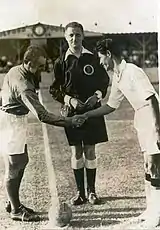India national football team at the Olympics
Football was first introduced as an Olympic sports at the Summer Olympic Games held in France in 1900. It was played by only three club teams from three nations as an exhibition sport and played again at the 1904 Games.[1][2] National sides played for the first time at the 1908 Summer Olympics. India did not send a football side to the Olympics until the 1948 Games; it participated in the next three Games.[3] An Indian team last participated in the 1960 Games. India's best appearance was at the 1956 Summer Olympics where its team reached the semi-finals.[4] Beginning with the 1992 Summer Olympics, the rules were changed so that only under-23 national teams are allowed to compete in the Games. India's U-23 national team has yet to qualify for the Olympic football competition.
History
Warm-up
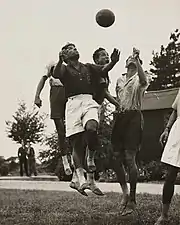
In 1948, London hosted the 1948 Summer Olympic Games. The Indian football team made its first Olympic appearance in a match against France. This was the first match played by a team from the newly independent India.[5][6] Coach Balaidas Chatterjee had prepared the team which successfully defeated Department Store XI 15–0 on 13 July, and the Metropolitan Police F.C. 3–1 on 16 July. The team then went on to defeat the Pinner FC by 9–1 on 24 July, Hayes F.C. by 4–1 on 26 July, and Alexandra Park FC by 8–2 on 28 July.[7][8][9]
Most of the Indian players were not accustomed to wearing boots and some having dislike of being shod.[10] However, during trials in India, the players wore boots as the pitch was wet due to heavy rain.[11] Thus during the Games, the Indian team decided to wear shoes if the conditions were wet and if they had to play on soft grounds. As conditions were dry,[12] most players opted to play without shoes and instead wore bandages to protect their feet. Of the eleven players who took the field against France eight players were barefooted, three wore boots.[7][13]
The match

On 31 July 1948, the first eleven men in independent India's footballing history walked to the middle of Cricklefield Stadium in front of 17,000 spectators wearing thick socks cut off at the ankles and bare feet strapped up to protect them and to provide grip. Taj Mohammad, Dhanraj, Papen wore boots. For the first 29 minutes neither team dominated proceedings, then in the 30th minute René Courbin gave France a 1–0 lead.[9][12] Just before half-time, Swedish referee Gunnar Dahlner awarded India a penalty kick; Sailen Manna missed it as the ball flew over the crossbar. In the second half Ahmad Khan created an opening, he combined with substitute B.N. Vajravelu, beat the French defense, and passed the ball to Sarangapani Raman who scored the equaliser in the 70th minute. His name was recorded as independent India's first international goal scorer. Ten minutes after Raman's equaliser, India had a chance to take the lead through another penalty. This time Mahabir Prasad's shot at the goal was saved by the French goalkeeper Guy Rouxel. With one minute to go before the final whistle René Persillon scored to give France a 2–1 victory and a place in the quarterfinals.[7][9][12]
Media and appreciation
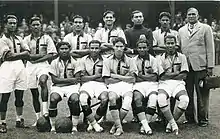
The Indian team was acknowledged and appreciated by the crowd for their good sportsmanship. "The French had been given a run for their money – and that, too, by the barefooted Indians!", the British media reported.[14][15] At a press conference, shortly after the match, the Indians were asked why they played barefooted. The Indian captain Talimeren Ao said, "Well, you see, we play football in India, whereas you play BOOTBALL!". This was applauded by the British and the next day Ao's comment was in the headlines of London's newspapers.[15][16]
While the 1–2 loss to France and first round elimination was a huge disappointment to the team and the public alike, the quality of football the team displayed had captivated one and all. The Indian footballers’ bravery and brilliance in bare feet at the 1948 Olympics earned them the admiration of Princess Margaret, the younger sister of Queen Elizabeth II.[17][18][19] King George VI invited the team to Buckingham Palace and there, as the story goes, he lifted up Sailen Manna's trouser leg, telling him it was just to check if he really had legs of steel as it appeared from the strength of his shots.[12][18] Encouraged by the accolades and the positive reception to India's football, the All India Football Federation (AIFF) decided to extend the tour with some friendlies across Europe over the next several weeks that enhanced the team's reputation at the time.[7][8][9]
1952, 1956, and 1960 Olympics
In 1952, under Sailen Manna's leadership at Helsinki, India would again lose in the first round, this time 10–1 to Yugoslavia.[20] The Yugloslavian Branko Zebec scored four of the ten goals for his side; the lone goal for the Indian side was scored by Ahmed Khan in the 89th minute as the final goal of the match.[21]
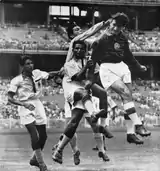
Four years later, at the 1956 Olympics in Melbourne, India attained its best outing at the Games as they reached the semi-finals of the tournament. The team was led by Samar Banerjee and India's most successful coach Syed Abdul Rahim,[22][23] who coached the team at both the 1952 and 1960 Olympics. India reached the first round without playing a scheduled preliminary match. The team received a walkover because Hungary did not play.[4] The team beat hosts Australia 4–2 and reached the semi-finals becoming the first Asian team to do so in Olympic history. At the match against Australia Neville D’Souza scored a hat trick.[22][24] He scored two goals in the first half at the ninth and 33rd minutes. The first was a nod to the rebound from captain Samar Banerjee's shot to the opponent's post. Then in the 33rd minute D'Souza converted a cross from P.K. Banerjee who sent the ball into the net from the right flank. A third goal was scored in the second half at the 50th minute when Banerjee converted a free ball received from a melee between Indian striker Muhammad Kannayan and Australian goalkeeper Ron Lord. The fourth Indian goal was scored by Krishna Kittu at the 80th minute. Bruce Morrow scored two goals for the hosts.[22][24]
However, India failed to reach the final losing to Yugoslavia by 4–1 in the semi finals. There were no goals scored in the first half. D'Souza scored the opening goal in the match for India at the 52nd minute, but in the next 15 minutes Yugoslavia scored three goals at the 54th, 57th and 65th minutes. A mistake by Indian defender Muhammad Salaam led to an own goal at the 78th minute ensuring Yugoslavia's victory in the match.[25] After the loss, India faced Bulgaria in the bronze medal match where they were again defeated by a score of 3–0.[26] With four goals Neville D’Souza became joint top scorer in that edition of the Games with Todor Veselinović of Yugoslavia and Dimitar Stoyanov of Bulgaria.[27]
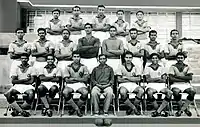
At 1960 Olympics in Rome, India was placed in a group with strong sides from Hungary, France and Peru.[4] The team was led by P.K. Banerjee under the coaching of Syed Rahim.[28] Tulsidas Balaram scored two goals, one each in the matches against Hungary and Peru, both of which India lost.[29][30] In the second match Banerjee's goal in the 71st minute would help India hold France to a draw.[31] With two losses and a draw, India placed at the bottom of the group and failed to move to the next round.[32] This was the last time India qualified for the Olympics in football.[33]
1964–present
From 1908 to 1988, football at the Olympics was played by senior national teams. Between these years the India national football team competed at Games from 1948 to 1960. From 1992, FIFA allowed only U-23 national teams to play in the tournament at the Olympics.[3] India withdrew from qualifying competition in the 1968, 1976 and 1988 Olympics.[34][35][36][37] For the 1964, 1972, 1980 and 1984 Olympics India failed to qualify.[38][39][40][41]
Though U-23 players were allowed, every qualifying matches from 1992 Olympics to the 2012 Olympics were played by India's senior national team. It failed to qualify for the Olympic finals from 1992 to 2012. The Asian Football Confederation (AFC) started the AFC U-23 Championship in 2013 which now acts as the qualifying tournament for the Olympics for Asian countries. The top three teams are allowed entry to the Olympic finals.[42] India has yet to qualify for the AFC U-23 Championship and thus for the Olympics since then.[43][44]
Records
India has played eight football matches at the Olympic Games, and managed one win, one draw, and lost in six of them.[31][45][33] India scored ten goals in seven matches against five different teams and conceded twenty-seven goals in eight matches against six different teams.[46] In 1948 and 1952, India was automatically qualified to play in the final tournament and for the 1956 Olympics, India was scheduled to play against Thailand in the qualification round, but both the teams got a bye as the Republic of China and the Philippines teams withdrew from the qualification round.[47]
For the 1960 Olympics, India was scheduled to play the first round of the qualification against Afghanistan. In the two-legged tie India won the away leg by 2−5 and in the home leg Afghanistan withdrew before the match. Eventually India moved to the second round where they defeated Indonesia in both legs and qualified for the Olympics.[48] 1960 Olympics would be India's last participation till date. From 1964 to 2012 India failed to qualify for the Olympics.[33] From 2016 onwards the AFC U-23 Championship was considered to be the qualification tournament for the Asian teams,[42] which India failed to progress from.[49][50]
| Summer Olympics record | Summer Olympics qualification record | ||||||||||||||
|---|---|---|---|---|---|---|---|---|---|---|---|---|---|---|---|
| Host/Year | Result | Position | Pld | W | T | L | GF | GA | Pld | W | T | L | GF | GA | |
| 1908–1936 | Did not enter | Did not enter | |||||||||||||
| Round 1 | 11th | 1 | 0 | 0 | 1 | 1 | 2 | Qualified automatically | |||||||
| Preliminaries | 25th | 1 | 0 | 0 | 1 | 1 | 10 | Qualified automatically | |||||||
| Semi-finals | 4th | 3 | 1 | 0 | 2 | 5 | 9 | Bye | |||||||
| Round 1 | 13th | 3 | 0 | 1 | 2 | 3 | 6 | 4 | 4 | 0 | 0 | 13 | 4 | ||
| Did not qualify | 4 | 2 | 0 | 2 | 13 | 9 | |||||||||
| Withdrew | |||||||||||||||
| 3 | 0 | 0 | 3 | 5 | 9 | ||||||||||
| Withdrew | |||||||||||||||
| 5 | 1 | 0 | 4 | 5 | 6 | ||||||||||
| 8 | 3 | 1 | 4 | 11 | 14 | ||||||||||
| Withdrew | |||||||||||||||
| FIFA allowed under-23 teams onward (India U-23 team) | Played by India national football team | ||||||||||||||
| Did not qualify | 4 | 0 | 1 | 3 | 3 | 7 | |||||||||
| 4 | 2 | 0 | 2 | 8 | 7 | ||||||||||
| 2 | 0 | 1 | 1 | 0 | 2 | ||||||||||
| 2 | 1 | 0 | 1 | 1 | 2 | ||||||||||
| 8 | 0 | 3 | 5 | 3 | 13 | ||||||||||
| 4 | 1 | 2 | 1 | 5 | 6 | ||||||||||
| Since 2016, AFC U-23 Championship acted as the AFC qualifier (top 3 finishers) | |||||||||||||||
| Did not qualify | Did not qualify 2016 AFC U-23 | ||||||||||||||
| Did not qualify 2020 AFC U-23 | |||||||||||||||
| To be determined | To be determined | ||||||||||||||
| Total | Semi-finals | 4 / 25 | 8 | 1 | 1 | 6 | 10 | 27 | 48 | 14 | 8 | 26 | 67 | 79 | |
Match summary
India has scored the most goals against Australia in a 4–2 victory at the 1956 Olympics, their biggest win in the Olympic history. The most goals the team conceded were in a 1–10 loss against Yugoslavia at the 1952 Olympics, their largest defeat to date.[33][46]
| Summer Olympics History | ||||
|---|---|---|---|---|
| Year | Round | Score | Result | Ref. |
| 1948 | Round 1 | India | Loss | [51] |
| 1952 | Prelim match | India | Loss | [21] |
| 1956 | Round 1 | India | † | [52] |
| Quarter-final | India | Win | [53] | |
| Semi-final | India | Loss | [25] | |
| India | Loss | [26] | ||
| 1960 | Group match | India | Loss | [29] |
| India | Draw | [31] | ||
| India | Loss | [30] | ||
- † At 1956 Olympics, India got a walkover as Hungary withdrew from the match due to Hungarian Revolution, thus India proceeded to QF without playing any match in the first round.[54]
Goalscorers

| No. | Player | Venue | Opponent | Date | Edition | Goals | Ref. |
|---|---|---|---|---|---|---|---|
| 1 | Sarangapani Raman | Criclefield Stadium, Ilford, London | 31 July 1948 | 1948 | 1 | [51] | |
| 2 | Ahmed Khan | Töölön Pallokenttä, Helsinki | 15 July 1952 | 1952 | 1 | [21] | |
| 3 | Neville D’Souza | Olympic Park Stadium, Melbourne | 1 December 1956 | 1956 | 3 | [53] | |
| 4 December 1956 | 1 | [25] | |||||
| 4 | Krishna Kittu | Olympic Park Stadium, Melbourne | 1 December 1956 | 1 | [53] | ||
| 5 | Tulsidas Balaram | Stadio Tommaso Fattori, L'Aquila | 26 August 1960 | 1960 | 1 | [29] | |
| Stadio Adriatico, Pescara | 1 September 1960 | 1 | [30] | ||||
| 6 | P. K. Banerjee | Stadio Olimpico, Grosseto | 29 August 1960 | 1 | [55] | ||
Coach, captain, and goalkeeper
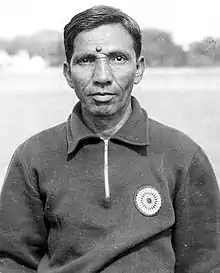
| Edition | Coach | Captain | Goalkeeper | Matches played | Ref. |
|---|---|---|---|---|---|
| 1948 London Olympics | Balaidas Chatterjee | Talimeren Ao | Kenchappa Varadaraj | 1 | [51] |
| 1952 Helsinki Olympics | Syed Abdul Rahim | Sailen Manna | Berland Anthony | 1 | [21] |
| 1956 Melbourne Olympics | Samar Banerjee | Peter Thangaraj | 1 | [22][25][26] | |
| S. S. Narayan | 2 ‡ | ||||
| 1960 Rome Olympics | P. K. Banerjee | Peter Thangaraj | 3 | [29][31][30] |
- ‡ S. S. Narayan was the goalkeeper for the team against Yugoslavia and Bulgaria and Peter Thangaraj kept the net for the quarter-final match against Australia at 1956 Olympics.
See also
References
- Elbech, Søren; Stokkermans, Karel. "Games of the II. Olympiad-football tournament". RSSSF. Archived from the original on 15 November 2019. Retrieved 15 November 2019.
- Elbech, Søren; Stokkermans, Karel. "Games of the III. Olympiad-football tournament". RSSSF. Archived from the original on 15 November 2019. Retrieved 15 November 2019.
- "FIFA Facts" (PDF). FIFA. Archived (PDF) from the original on 24 September 2015. Retrieved 7 January 2019.
- Ayush Srivastava. "India's Olympic Heroes: Babu Narayan takes us through his 1956 and 1960 experience". www.goal.com. Archived from the original on 2019-01-10. Retrieved 10 January 2019.
- Sen, Ranojoy (20 July 2012). "London, 1948: India's first Olympics as an independent nation". The Times of India. Archived from the original on 8 February 2019. Retrieved 22 January 2019.
- "Indian football history". Sportskeeda. Archived from the original on 22 January 2019. Retrieved 22 January 2019.
- Dutta, Anindya. "When India almost beat France at football". sportstar.thehindu.com. The Hindu. Archived from the original on 18 September 2019. Retrieved 16 December 2018.
- Morrison, Neil. "Indian Olympic team tour of Europe 1948". RSSSF. Archived from the original on 10 March 2019. Retrieved 19 September 2019.
- Daniel, Chris Punnukattu. "India's 1948 Europe tour & the first international match". blog.cpdfootball.de. Archived from the original on 28 September 2018. Retrieved 18 September 2019.
- "Six Mysore players in Olympic contingent". The Indian Express. 8 May 1948. Retrieved 27 June 2020.
- "Mysore players among scorers in the soccer trial". The Indian Express. 7 May 1948. Retrieved 27 June 2020.
- Rajan Thambehalli (9 July 2015). "Almost famous – The journey of the first Indian international football team at the 1948 Olympics". Sportskeeda. Archived from the original on 28 September 2018. Retrieved 16 December 2018.
- "France beats India at the Olympic soccer". The Indian Express. 31 July 1948. Retrieved 27 June 2020.
- "Story of a legend – Dr. T. Ao the first Naga Olympian and football genius". The Naga Republic. 27 January 2018. Archived from the original on 17 February 2020. Retrieved 17 February 2020.
- Kapadia, Novy (14 September 2010). "Triumphs and Disasters: The Story of Indian Football, 1889-2000" (PDF). Soccer and Society. 2, 2001 (2): 23,24. Archived from the original (PDF) on 13 August 2012. Retrieved 17 February 2020.
- "Brief life sketch of Dr T Ao, the First Naga Olympian". The Morung Express. 27 January 2018. Archived from the original on 19 August 2018. Retrieved 15 August 2018.
- "fifa 1948 India olympic story". FIFA. Archived from the original on 28 September 2018. Retrieved 28 September 2018.
- "Sailen Manna". The Economist. 17 March 2012. Archived from the original on 30 September 2018. Retrieved 30 September 2018.
- Amitabh, Sharma (15 April 2006). "India's greatest footballer Sailen Manna". sportstarlive.com. The Hindu. Archived from the original on 15 November 2019. Retrieved 30 September 2018.
- Chaudhuri, Arunava. "The Indian senior team at 1952 Helsinki Olympics". indianfootball.de. Archived from the original on 3 December 2018. Retrieved 17 December 2018.
- "Olympic football tournament Helsinki 1952". FIFA. Archived from the original on 12 May 2019. Retrieved 10 January 2019.
- "Match report Australia vs India, 1956 Olympics". FIFA. Archived from the original on 15 July 2018. Retrieved 10 January 2019.
- Chaudhuri, Arunava. "The senior Indian team at the 1956 Olympics". indianfootball.de. Archived from the original on 16 February 2019. Retrieved 18 September 2019.
- Roy, Gautam (1 December 2016). "60 years ago today, India's Melbourne magic created history". ESPN. Archived from the original on 15 November 2019. Retrieved 19 September 2019.
- "Match report India vs Yugoslavia". FIFA. Archived from the original on 28 September 2018. Retrieved 10 January 2019.
- "Match report Bulgaria vs India 1956". FIFA. Archived from the original on 22 November 2018. Retrieved 10 January 2019.
- "Player-top goalscorer 1956 Olympics". FIFA. Archived from the original on 24 July 2018. Retrieved 28 September 2018.
- Chaudhuri, Arunava. "The Indian senior national team at the 1960 Rome Olympics". indianfootball.de. Archived from the original on 12 January 2019. Retrieved 10 January 2019.
- "Matches 1960 Hungary". FIFA. Archived from the original on 5 July 2018. Retrieved 28 September 2018.
- "Match report Peru vs India, 1960 Rome". FIFA. Archived from the original on 5 July 2018. Retrieved 28 September 2018.
- "Match 1960 France vs India". FIFA. Archived from the original on 28 September 2018. Retrieved 28 September 2018.
- "Olympic Football tournament 1960, Rome". FIFA. Archived from the original on 10 January 2019. Retrieved 10 January 2019.
- Chaudhuri, Arunava. "The India National team at the Olympics". indianfootball.de. Archived from the original on 25 February 2019. Retrieved 19 September 2019.
- Miron, Goihman. "Games of the XIX. Olympiad- football qualifying tournament". RSSSF. Archived from the original on 4 January 2016. Retrieved 9 January 2019.
- Elbech, Soren. "Games of the XXI. Olympiad football qualifying tournament". RSSSF. Archived from the original on 4 March 2016. Retrieved 9 January 2019.
- Aarhus, Lars. "Games of the XXIV. Olympiad- football qualifying tournament". RSSSF. Archived from the original on 3 March 2016. Retrieved 9 January 2019.
- Chaudhuri, Arunava. "The India national team at Olympics qualifying". indianfootball.de. Archived from the original on 3 September 2018. Retrieved 10 January 2019.
- Jonsson, Mikael. "Games of the XVIII. Olympiad football qualifying tournament". RSSSF. Archived from the original on 3 March 2016. Retrieved 9 January 2019.
- Morrison, Neil. "Games of the XX. Olympiad- football qualifying tournament". RSSSF. Archived from the original on 3 March 2016. Retrieved 9 January 2019.
- Elbech, Soren. "Games of the XXII. Olympiad- football qualifying tournament". RSSSF. Archived from the original on 15 March 2013. Retrieved 9 January 2019.
- Morrisson, Neil. "Games of the XXIII. Olympiad football qualifying tournament". RSSSF. Archived from the original on 4 March 2016. Retrieved 9 January 2019.
- "Qualification system-Games of the XXXI Olympiad-Rio 2016-Football" (PDF). rio2016.com. FIFA. 23 April 2014. Archived from the original (PDF) on 6 September 2015. Retrieved 10 January 2019.
- "India to start preparations for U-23 AFC championship". IANS. The Outlook India. 23 February 2019. Archived from the original on 2 May 2020. Retrieved 17 February 2020.
- "India U-23 lose to Tajikistan, fail to qualify for AFC U-23 Championship 2020". AIFF. Khel Now. 24 March 2019. Archived from the original on 2 May 2020. Retrieved 17 February 2020.
- Mitra, Atanu. "1956 Olympics football Report: Australia 2–4 India: Neville D'Souza's hat-trick takes Rahim's team to the semi-finals". www.goal.com. Archived from the original on 5 August 2018. Retrieved 19 September 2019.
- "India at Olympics: 4 Olympics, Best Position 4th & a Hattrick for Football". newschoupal.com. Archived from the original on 11 September 2017. Retrieved 19 September 2019.
- Gerrard, Russell. "Games of the XVI. Olympiad football qualifying tournament (Melbourne, Australia, 1956)". RSSSF. Archived from the original on 11 January 2014. Retrieved 19 September 2019.
- Morrison, Neil; Gerrard, Russell. "Games of the XVII. Olympiad football qualifying tournament (Roma, Italy, 1960)". RSSSF. Archived from the original on 3 March 2016. Retrieved 19 September 2019.
- "India out to break AFC U23 C'ship qualification jinx". ANI. The Business Standard. 20 March 2019. Archived from the original on 12 September 2019. Retrieved 19 September 2019.
- "India bow out of AFC U-23 Championships qualifiers after loss to Tajikistan". PTI. The India Today. Archived from the original on 25 March 2019. Retrieved 19 September 2019.
- "1948 OLY. tournament Ind vs Fra". FIFA. Archived from the original on 10 June 2017. Retrieved 10 January 2019.
- Gerrard, Russel. "Games of the XVI. Olympiad football qualifying tournament". RSSSF. Archived from the original on 11 January 2014. Retrieved 9 January 2019.
- Esamie, Thomas; Stock, Greg. "Socceroo internationals for 1956". ozfootball.net. Retrieved 22 October 2019.
- "Overview: 1956 Melbourne Olympics". FIFA. Archived from the original on 11 July 2019. Retrieved 20 September 2019.
- Reyes, Macario. "XVII. Olympiad Rome 1960 football tournament". RSSSF. Retrieved 22 October 2019.
External links
- "Olympic Football Tournament archive". FIFA.
- "Indian football at the Olympics: The complete history". Olympic Channel.
- "Football at 1948 Olympics". FIFA.
- "Football at 1952 Olympics". FIFA.
- "Football at 1956 Olympics". FIFA.
- "Football at 1960 Olympics". FIFA.
- "India Olympics Qualifiers list". IndianFootball.
- "Football Tournament of the Olympics-Details". RSSSF.
- "Olympics-Qualifying all time records". RSSSF.
- "India". Sports-Reference.com. Archived from the original on 2016-03-03.
